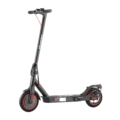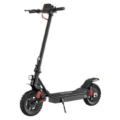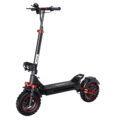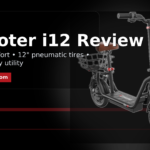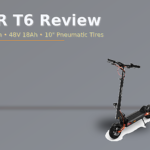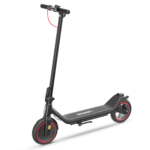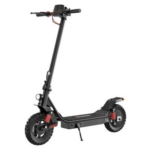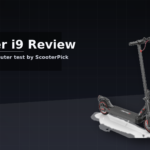- Home
- Scooters
- Electric Scooters
- iScooter i9L
iScooter i9L
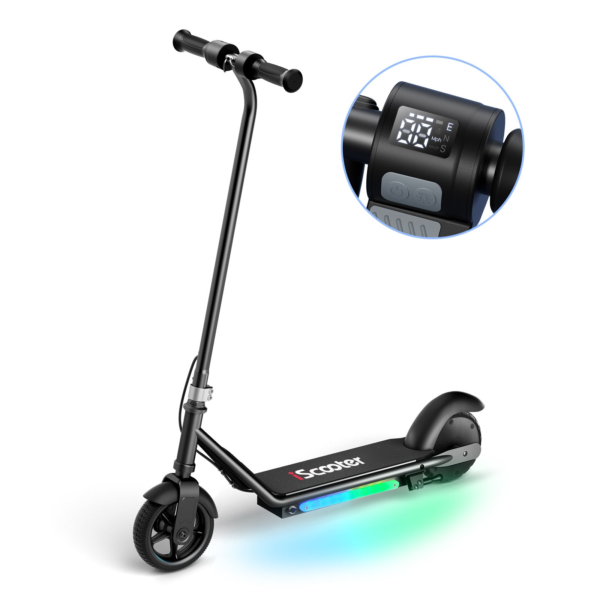



- Battery Range: 18 miles (29 km)
- Top Speed: 13–19 mph (30 km/h region-limited)
- Motor Power: 350 W front hub
- Weight Capacity: 220 lb (100 kg) max rider
- Charging Time: 36 V 7.5 Ah, ~3–6 h charge
- Scooter Weight: 25.7 lb (11.65 kg) scooter weight
PROS
- Very light at ~11.65 kg
- Pneumatic tires add comfort
- 3 ride modes + cruise
- IP54 splash resistance
- Quick, compact fold
CONS
- No suspension
- Air tires can puncture
- Range modest vs. larger packs
- FWD can slip on loose grit
Table of contents
- What Is the iScooter i9L?
- How the iScooter i9L Works
- Key Specifications
- Design & Build Quality
- Performance Fundamentals
- Battery, Range & Efficiency
- Ride Quality & Comfort
- Braking & Safety Features
- Portability & Daily Usability
- Maintenance & Care
- Weather & Seasonal Considerations
- iScooter i9L vs Alternatives
- Who the iScooter i9L Is (and Isn’t) For
- FAQs
- Glossary
- Final Thoughts
If you want a light, simple, and reliable kickstart to city commuting, the iScooter i9L fits the brief. It packs the essentials—350W hub motor, 36V battery, rear disc + electronic braking, and 8.5-inch pneumatic tires—into a compact, easy-to-lift frame. Because it favors practicality over flash, it suits new riders, students, and last-mile commuters who want a straightforward scooter that “just works.”
What Is the iScooter i9L?
The iScooter i9L is an entry-level commuter scooter designed for short, predictable trips with minimal fuss. It emphasizes portability, user-friendly controls, and a forgiving ride. The weight comes in around 25.7 lb (11.65 kg), so you can carry it upstairs, load it into a trunk, or roll it through a lobby without drawing a crowd. Meanwhile, its 350W front hub motor targets city speed limits and flat-to-moderate terrain rather than big hills.
Unlike heavy dual-motor machines, the i9L uses a simple architecture: a single hub motor up front, a 36V 7.5Ah battery in the deck, and a thumb throttle on the bar. Because of that simplicity, maintenance stays light. You inflate the tires, keep the brake aligned, charge the pack, and go. As a result, the i9L makes a sensible first scooter or a dedicated “last-mile” tool for multi-modal commuters.
How the iScooter i9L Works
Think of a hub motor like a bicycle wheel with a small, efficient engine built inside. When you press the thumb throttle, the controller—an electronic brain—meters power from the battery to the motor. Therefore, you get smooth acceleration without any gears to shift.
- Motor: A 350W brushless hub motor sits in the front wheel. Because the motor is integrated, there’s no chain, belt, or sprocket to maintain.
- Controller: The controller interprets throttle input and blends in electronic braking (regen) when you pull the lever. Consequently, it balances power and safety.
- Battery: A 36V 7.5Ah pack (about 270Wh) lives in the deck. It feeds the motor with enough energy for typical short commutes, especially at moderate speeds.
- Throttle: A thumb-press throttle on the right handlebar makes fine speed control intuitive, even in traffic.
- Brakes: A rear mechanical disc handles the hard stops, while an electronic brake (EABS) in the motor adds regenerative drag. Together, they provide confidence and redundancy.
Because there’s no suspension, the tires handle small bumps. The 8.5-inch pneumatic format adds cushion and grip, which, in practice, matters more day-to-day than budget coil springs.
Key Specifications
The figures below reflect typical manufacturer-published details for the i9L and include both imperial and metric units where useful.
| Block | Details |
|---|---|
| General | Model: iScooter i9L • Drive: Front-wheel hub motor • Frame: Folding aluminum alloy • Display: LED readout (speed/mode/battery) • Companion app: Supported (Bluetooth) |
| Performance & Power | Motor power: 350W • Top speed: up to 19 mph (30 km/h), mode-dependent • Speed modes: 3 • Typical urban grades: handles mild hills; expects speed drop on 7–10% |
| Battery, Charging & Electrical | Battery: 36V 7.5Ah (~270Wh) • Charging time: ~3–6 hours • Charger: standard deck-port charger • Lights: front LED headlight + rear LED brake light • Electronic brake: EABS/regen |
| Build & Dimensions | Weight: ~25.7 lb (11.65 kg) • Tires: 8.5 in (21.6 cm) pneumatic • Unfolded (approx): 42 × 17 × 44 in (106.7 × 43.2 × 111.8 cm) • Folded (approx): 42 × 17 × 19 in (106.7 × 43.2 × 48.3 cm) • Handlebars: fixed width • Stem: non-adjustable |
| Safety & Control | Rear mechanical disc + electronic regen (front) • Thumb throttle • Bell and reflectors • Water resistance: IP54 for light splashes and dust |
| Features & Extras | Cruise control (enable via display/app), walk-assist/zero-start toggles (via app on some batches), ride data in app, basic diagnostics, mudguards front/rear |
| Warranty & Compliance | Typical warranty: 12 months on scooter (region-specific); user responsibility to follow local e-mobility rules and speed limits |
Notes: Published dimensions sometimes appear inverted by height (folded vs. unfolded). The values above reflect the common real-world orientation—folded height is shorter, unfolded height is taller.
Design & Build Quality
The i9L frame uses an aluminum alloy that balances strength and weight. The deck is long enough for a natural stance without overhang, and the griptape offers decent traction in dry conditions. Because the battery sits inside the deck, the center of gravity stays low, which helps straight-line stability.
The stem is a single-tube design with a locking latch at the base. The latch engages with a satisfying click when open, and it folds with one lever motion. As with most budget commuters, the mechanism uses pins and a clamping interface rather than heavy cast blocks; check it periodically, and it remains tight.
Up top, the cockpit is straightforward: a central LED display, a right-side thumb throttle, a left-side brake lever, and a simple bell. Grips are foam sleeves—comfortable in mild weather, though rubber grips resist rain better. Cable routing is external and visible, which simplifies service if you ever swap a lever, throttle, or headlight.
Because the scooter forgoes suspension, tire selection matters. The 8.5-inch pneumatic format absorbs chatter and provides grip on gritty tarmac. Therefore, proper inflation pays off more than any budget shock would. Keep the tires healthy, and the ride stays composed.
Performance Fundamentals
Acceleration feel: From a push-off, the i9L brings the front wheel to life smoothly. In the first 10 meters, the 350W motor delivers a steady build rather than a hard shove. That behavior helps new riders keep balance. As speed rises, the power curve flattens, so you can roll into cruise without drama.
Cruising stability: At neighborhood speeds, the scooter tracks straight with little bar input. Because of the low deck battery and pneumatic tires, micro-wobbles settle quickly. At the high end of its range—near 19 mph (30 km/h)—the light chassis can feel more reactive to rider inputs. A relaxed, light grip and knees bent slightly will keep it planted.
Hill-climb behavior (~7–10% grades): On short city ramps and overpasses, the motor keeps momentum when you enter with a rolling start. However, expect speed to drop on sustained 8–10% grades. That’s normal for 350W class commuters. If you climb often, choose a lower speed mode, lean forward a touch for front-wheel traction, and keep cadence steady.
Noise & vibration: The brushless motor is quiet, and the drivetrain has no chains or belts to rattle. Most noise comes from tires on coarse pavement and the rear disc pads if misaligned. A quick caliper tune eliminates most squeal.
Battery, Range & Efficiency
The i9L’s 36V 7.5Ah pack holds roughly 270Wh (36 × 7.5). In gentle city riding—cruising 10–13 mph (16–21 km/h) on flat ground with few stops—many riders see 12–15 miles (19–24 km). Push to top speed, ride in cold weather, or carry a heavy backpack, and real-world range typically lands around 9–12 miles (14–19 km). Because energy use scales with speed and starts/stops, smooth throttle inputs stretch distance.
Variables that matter:
- Rider mass: Higher mass increases rolling resistance and energy demand.
- Temperature: Lithium-ion cells deliver less in the cold; expect a modest drop below ~50°F (10°C).
- Terrain: Stops, hills, and rough tarmac consume more watt-hours per mile.
- Tire pressure: Under-inflation wastes energy and feels sluggish; proper pressure improves both range and grip.
Charging best practices:
- Top off within reason. You don’t need to sit at 100% every night. However, leaving the pack between ~30% and ~80% for daily use helps longevity.
- Avoid deep storage drain. If you won’t ride for weeks, store around 50–60% charge and recharge monthly.
- Charge at room temperature. Extreme heat and cold stress cells.
- Check the port and plug. Keep the charging port dry and the rubber cap seated after rides.
Because the battery is modest in size, the pack recharges in roughly 3–6 hours, depending on how low you start and the exact charger batch. As a result, most commuters can charge at home and skip mid-day top-ups.
Ride Quality & Comfort
Tires vs. suspension: The i9L uses 8.5-inch pneumatic tires without suspension. That choice keeps weight low and maintenance simple, yet it still filters vibration from patched city asphalt. Compared to solid tires, pneumatic tubes ride noticeably softer and grip better when the road is dusty or damp. Consequently, you can lean with more confidence in slow corners.
Ergonomics: The deck length supports a staggered stance—front foot at 45°, back foot across. The bar height suits most riders up to average tall. Very tall riders may prefer a slightly bent-elbow stance to keep the shoulders relaxed.
Stem flex: Single-tube stems flex a bit under load, which is normal. On the i9L, flex stays within a comfortable range for riders under about 100 kg (220 lb). If you feel a creak, check the latch screws and stem clamp for torque.
Vibration control: Proper tire inflation does the heavy lifting. Inspect your tires weekly. Keep them within the stated range on the sidewall, adapting a few psi for rider mass and comfort. In practice, slightly firmer front pressure sharpens steering, while a touch softer in the rear helps small-bump comfort.
Braking & Safety Features
Brake system: The i9L pairs a rear mechanical disc with EABS electronic braking up front. The lever engages the disc first; as you squeeze more, the controller adds regen drag. The feel is progressive, not grabby. Therefore, you can feather speed on bike paths without pitching forward. In emergency stops, shift hips back to load the rear tire and maintain stability.
Lights & reflectors: A front LED headlight and rear LED brake light cover visibility. Still, treat the stock headlight as a “be seen” light. If you ride after dark, consider adding a brighter helmet-mounted beam so you can look through turns.
Ingress protection: IP54 means the scooter handles light splashes and dust. That rating is intended for drizzle and wet pavement, not standing water. Avoid pressure washers and deep puddles.
Controls & alerts: The thumb throttle keeps your hand in a natural position, and the bell is within easy reach. The on-bar LED shows speed, battery bars, and selected mode at a glance. Some units also let you toggle zero-start and cruise via a companion app.
Portability & Daily Usability
Weight & carry: At about 25.7 lb (11.65 kg), the i9L is genuinely manageable. You can carry it one-handed up a flight of stairs, especially if you hold the deck rail near the center. Because the deck houses the battery, balance point sits close to the middle.
Folding & latching: The base latch folds the stem down toward the deck. The folded package is roughly 42 × 17 × 19 in (106.7 × 43.2 × 48.3 cm), which slides behind a desk or in the trunk easily. Always verify the latch clicks fully before riding; give the stem a gentle tug to confirm.
Storage: An apartment corner or office wall works well. Keep it away from heating elements and direct sun. When you come in from the rain, wipe moisture from the deck and charge only after the scooter is dry.
Security habits: Use a hardened U-lock or quality folding lock through the rear triangle and wheel if you must park outside briefly. Better yet, bring it indoors. Lightweight scooters are attractive targets.
Maintenance & Care
A simple scooter needs a simple routine. Here’s a reliable schedule:
- Before each ride (30 seconds):
Check tire firmness with a thumb press, eyeball the brake rotor for rub, and confirm the latch is fully locked. - Weekly:
Inspect tire tread, look for cuts, and spin each wheel to ensure it tracks true. Verify the brake lever pull is firm and centered. - Monthly:
Torque-check stem latch bolts and brake caliper bolts. Clean the deck and brake rotor. Update firmware if the app prompts you. - Every 2–3 months:
Top up the tire pressure precisely with a gauge. Realign the rear caliper if you hear intermittent scrape. Examine brake pads for wear. - Storage:
If you pause riding for more than a few weeks, store around half charge and recharge monthly to keep the pack healthy.
Tire care tips: Keep a spare inner tube and a compact pump with a valve extender. Because the front wheel houses the motor, tube swaps are quicker at the rear. However, both are doable with patience and the right hex keys.
Brake alignment basics: Loosen the two caliper bolts slightly, squeeze the lever to center the caliper over the rotor, then re-tighten while holding the lever. Spin the wheel to verify silence. If it still scrapes, add a paper-thin shim under the mounting face or micro-adjust by hand.
Weather & Seasonal Considerations
Rain: IP54 handles spray, but water still raises risk. Brake earlier, stand taller, and keep speeds conservative. Because painted lines and metal plates become slick, cross them upright. After wet rides, dry the rotor, wipe the deck, and charge only once the scooter returns to room temperature.
Cold: Below 50°F (10°C), expect less range. Lithium cells prefer warmth. Pre-warm the scooter indoors, ride with a smoother throttle, and plan a shorter loop. As temperatures approach freezing, traction also falls; lean less, brake earlier, and inflate tires to the lower end of your range for a touch more contact patch.
Heat: Above 86°F (30°C), shade the scooter when parked and avoid leaving it in a hot car. High heat accelerates battery aging. If the deck feels hot to the touch, give it time before charging.
iScooter i9L vs Alternatives
Ultralight last-mile scooters: The i9L is a step above tiny 250W models. It accelerates better, holds speed longer, and rides softer thanks to pneumatic tires. However, true featherweights can be 3–5 lb lighter, which matters if you carry it all day.
Mainstream commuters (single motor, larger packs): Scooters with 10-inch tires and 500W motors climb better and stop harder, yet they weigh more and cost more. For comparison, models like the JOYOR F3 typically bring a bigger battery and stronger hill hold, but they add a few pounds you’ll feel on stairs.
Performance scooters (dual motor): These are in a different league for speed and power. They also weigh two to three times as much and require more upkeep. Unless your commute demands bursts above urban limits or you ride off-road frequently, the i9L’s simplicity wins for daily use.
Off-road/dual-suspension platforms: Full suspension and knobby tires smooth rough trails but add mass and complexity. The i9L’s pneumatic street tires handle patched city roads well; it’s not built for ruts, roots, or gravel climbs.
Who the iScooter i9L Is (and Isn’t) For
Ideal for:
- Students and first-timers who want a clear, low-maintenance start.
- Multi-modal commuters who ride a few miles, then hop a train or bus.
- Apartment dwellers who need a light foldable they can stash indoors.
- Short-hop errands where quick folding and nimble steering matter more than raw speed.
Not ideal for:
- Hilly suburbs with long, steep grades.
- Heavy riders carrying heavy bags who want brisk acceleration uphill.
- Rough-trail users who need suspension and wider tires.
- Speed seekers aiming far beyond 20 mph (32 km/h).
If your daily loop stays within 3–6 miles one way, mostly flat, and you can charge at home, the iScooter i9L hits a sweet spot between convenience and capability.
FAQs
1) How fast does it go?
In high mode on flat ground, it can reach up to 19 mph (30 km/h). However, rider weight, wind, and road texture all affect top speed.
2) What real-world range should I expect?
Plan on 9–15 miles (14–24 km) depending on speed, temperature, and hills. Because smooth riding reduces energy spikes, you’ll go farther if you avoid full-throttle sprints.
3) Can it climb hills?
Yes, but it prefers short, moderate grades. On 7–10% climbs, expect speed to drop. Enter with a small rolling start and choose a lower mode for steadiness.
4) Is the iScooter i9L water-resistant?
It carries an IP54 rating for light splashes and dust. Even so, avoid deep puddles and do not pressure-wash the scooter.
5) What maintenance is required?
Keep tires properly inflated, check the brake caliper alignment monthly, and ensure the folding latch bolts are snug. Charge at room temperature and store near half charge if you won’t ride for weeks.
6) Does it have cruise control and an app?
Yes. Many i9L units support cruise control and a Bluetooth companion app for basic settings like modes, zero-start toggles, and ride data.
7) Where can I find the “iScooter i9L overview” in one place?
You’re reading it. This page consolidates design, performance, care, and suitability details so you can evaluate the scooter quickly and confidently.
Glossary
- Ah (Amp-hours): Battery capacity. Higher Ah means more stored charge.
- Wh (Watt-hours): Battery energy (volts × amp-hours). A direct measure of range potential.
- Controller: The electronic unit that manages power flow between the battery and motor.
- Regen (Regenerative Braking): The motor acts as a generator to slow the scooter and recover a bit of energy.
- EABS: Electronic Anti-lock Braking System; a controller-managed electronic brake that resists wheel lock during deceleration.
- Hub Motor: A motor integrated into the wheel, eliminating chains or belts.
- Stem Flex: The slight, normal bending of the handlebar stem under load.
- IP Rating: Ingress Protection; measures resistance to dust and water (e.g., IP54).
- Zero-Start: A mode that lets the scooter accelerate from a standstill without a push-off.
- Kick-to-Start (Non-Zero-Start): Requires a small push before the motor engages for safety.
- Pneumatic Tire: An air-filled tire that improves comfort and grip compared to solid rubber.
- Caliper: The clamp mechanism that squeezes brake pads onto the rotor.
- Rotor: The circular disc attached to the wheel; the caliper clamps it to slow the scooter.
- Watt (W): A unit of power; higher watts generally mean stronger acceleration potential.
- Torque: The rotational force from the motor; more torque helps on hills and starts.
Final Thoughts
The iScooter i9L is a practical, portable commuter for riders who value simplicity, light weight, and low running costs. It favors clean starts, predictable braking, and a comfortable tire-based ride instead of complex suspension. Because it’s easy to lift and easy to live with, it makes everyday transport more approachable—especially for new owners and city dwellers. If your needs are modest and your routes are sensible, it’s a smart, confidence-building choice.
Specifications
General
| Model The Model specifies the exact version or name of the scooter. It helps identify its unique design, features, and specifications within the manufacturer’s product line. Knowing the model makes it easier to compare options, find compatible accessories, or look up support information. | iScooter i9L |
| Brand The Brand identifies the manufacturer or company that designs and produces the scooter. A trusted brand is a sign of quality, reliability, and good customer support. Well-known brands often have higher standards for safety, performance, and after-sales service, giving you more confidence in your purchase. | iScooter |
| Release Date The Release Date indicates when the scooter model was officially launched on the market. This helps you know how current the design, technology, and features are. A newer release date often means updated components, improved performance, and the latest safety or smart features. | 17 November 2025 |
| Recommended Age Recommended Age indicates the minimum age range that the scooter is designed for, based on safety, size, and ease of use. Following the recommended age helps ensure that riders can handle the scooter’s speed, weight, and controls comfortably and safely. Always check local laws and use protective gear, especially for younger riders. | Recommended 12+ |
Performance & Power
| Motor Power (Wattage) What it means: The motor power, measured in watts (W), shows how strong the scooter’s electric motor is. Why it matters: Higher wattage usually means better acceleration, more torque, and improved performance on hills or rough terrain. For example, a 250W motor is good for flat city roads and light riders, while a 500W or 1000W motor provides more power for faster speeds or climbing steep inclines. | 350 W front hub motor |
| Top Speed The Top Speed indicates the maximum speed that the scooter can reach under optimal conditions. It’s usually measured on level ground with a fully charged battery and an average rider weight. A higher top speed allows you to travel longer distances faster, but always ensure you ride within legal speed limits and your personal comfort zone for safety. | 13–19 mph (30 km/h) |
| Battery Capacity Battery Capacity refers to the total amount of energy the scooter’s battery can store, usually measured in ampere-hours (Ah) or watt-hours (Wh). A higher battery capacity means you can ride longer distances on a single charge, reducing the need for frequent recharging. Keep in mind that actual range can vary depending on rider weight, terrain, speed, and weather conditions. | 36 V 7.5 Ah |
| Estimated Range per Charge The Estimated Range per Charge indicates the average distance the scooter can travel on a single full battery charge. This range is calculated under optimal conditions, such as flat terrain, moderate speed, and average rider weight. Real-world range may vary depending on riding style, terrain, weather, and load. A longer range means fewer recharges and greater freedom for longer trips. | 18 miles (29 km) |
| Hill Climb Ability Hill Climb Ability describes the maximum incline or slope that the scooter can handle while maintaining stable performance. It’s typically expressed as a percentage or in degrees. A higher hill climb rating means the scooter can tackle steeper hills without losing too much speed or power. Actual climbing performance may vary based on rider weight, battery charge, and terrain conditions. | Not specified |
| Drive System The Drive System refers to how power from the motor is delivered to the wheels. Electric scooters typically use either a hub motor (directly integrated into the wheel) or a chain/belt drive system. A high-quality drive system ensures smooth acceleration, efficient power transfer, and low maintenance. The choice of drive system affects performance, noise level, and overall ride experience. | Front hub motor (FWD) |
Charging & Electrical
| Charging Time Charging Time indicates how long it takes to fully recharge the scooter’s battery from empty to 100% using the standard charger provided. Faster charging means less downtime and more time on the road. Actual charging time may vary slightly depending on battery capacity, charger output, and environmental conditions. | Approx. 3–6 hours |
| Battery Type Battery Type refers to the specific technology used in the scooter’s battery, which affects performance, lifespan, weight, and charging time. Most modern electric scooters use high-quality lithium-ion (Li-ion) batteries because they offer a good balance of energy density, durability, and low maintenance. A reliable battery type ensures consistent power delivery and longer riding ranges. | Lithium-ion pack |
| Removable Battery A Removable Battery means the battery pack can be easily detached from the scooter for convenient charging and replacement. This feature allows you to charge the battery separately, swap it with a spare for extended range, or securely store it indoors in extreme weather. Removable batteries add flexibility and make it easier to keep your scooter powered up wherever you are. | Non-removable internal battery (fixed pack) |
| Regenerative Braking Regenerative Braking is an energy-saving feature that converts some of the energy normally lost during braking back into battery power. When you slow down or brake, the motor works in reverse to generate electricity, which helps extend the scooter’s range and improves overall efficiency. This system also reduces wear on traditional brake components, leading to lower maintenance over time. | Yes (regen via electronic brake) |
| Lighting Lighting refers to the built-in front and rear lights that enhance visibility and safety when riding in low-light conditions or at night. Good lighting helps you see the road ahead and ensures that other road users can see you. Many scooters include LED headlights, taillights, and sometimes brake lights or side reflectors for added safety and compliance with local traffic regulations. | LED headlight + rear LED/brake + reflectors |
Build & Dimensions
| Scooter Weight Scooter Weight refers to the total weight of the scooter when fully assembled, including the battery. This affects how easy it is to carry, lift, and store the scooter when not in use. A lighter scooter is more portable and convenient for commuting, especially if you need to carry it upstairs or onto public transport. Keep in mind that a sturdy frame and quality components may add to the weight but also contribute to better durability and ride stability. | 25.7 lb (11.65 kg) |
| Maximum Rider Weight Maximum Rider Weight indicates the highest rider weight that the scooter is designed to safely support while maintaining optimal performance and stability. Staying within this limit helps ensure reliable acceleration, braking, and climbing ability, and it protects the frame, suspension, and motor from excessive strain. Exceeding the recommended limit may reduce performance and increase wear on components. | 220 lb (100 kg) |
| Deck Size Deck Size refers to the dimensions of the scooter’s standing platform. A wider and longer deck provides more foot space, allowing you to stand comfortably and adjust your stance while riding. A well-sized deck improves balance and stability, especially on longer rides or at higher speeds. Compact decks, on the other hand, help keep the scooter lightweight and portable. | Low deck; compact stance |
| Handlebar Height Handlebar Height refers to the distance from the deck to the handlebars, which affects your riding posture and comfort. An appropriate handlebar height helps you maintain good balance, reduces strain on your back and arms, and makes steering more comfortable. Some scooters have adjustable handlebars to fit riders of different heights, while others have a fixed height for a streamlined design. | Fixed bar height |
| Folding Mechanism The Folding Mechanism describes how easily and securely the scooter can be folded for carrying and storage. A well-designed folding system lets you quickly collapse the scooter into a compact size, making it convenient to transport on public transit, store under a desk, or fit into a car trunk. Look for sturdy latches and safety locks to ensure the scooter stays firmly in place when folded or unfolded. | Quick folding latch |
| Dimensions Folded Dimensions indicate the size of the scooter when it’s fully folded. This measurement shows how much space the scooter will take up when stored or carried, making it easier to check if it will fit in your car trunk, under a desk, or in a closet. Compact folded dimensions are ideal for commuters who need to bring their scooter on public transport or store it in tight spaces. | Approx. 42 × 17 × 44 in (folded); 42 × 17 × 19 in (unfolded) [brand listing] |
| Material Material refers to the primary construction materials used for the scooter’s frame and key components. High-quality materials like aircraft-grade aluminum, reinforced steel, or durable composites provide strength, stability, and a lighter overall weight. A sturdy material ensures the scooter can handle daily wear and tear while maintaining safety and performance. | Aluminum alloy |
Safety & Control
| Brake Type(s) Brake Type(s) describe the braking systems the scooter uses to help you slow down or stop safely. Common brake types include mechanical brakes (like drum or disc brakes), electronic brakes, and foot brakes. Many scooters combine multiple braking systems for added safety and shorter stopping distances. The type and quality of brakes affect your control, especially when riding at higher speeds or on slopes. | Front electronic + rear mechanical (brand double braking) |
| Suspension Suspension refers to the system that absorbs shocks and vibrations while riding, providing a smoother and more comfortable ride over uneven or rough surfaces. Scooters may have front suspension, rear suspension, or dual suspension for better shock absorption and stability. Good suspension helps reduce rider fatigue and improves control, especially when riding on bumpy roads or off-road paths. | None |
| Tire Type Tire Type refers to the kind of tires the scooter uses, which directly affects ride comfort, traction, and maintenance. Common types include solid (airless) tires, pneumatic (air-filled) tires, or hybrid options. Pneumatic tires offer better shock absorption and a smoother ride on rough surfaces, while solid tires are puncture-proof and require less upkeep. The right tire type helps ensure safe handling and a comfortable ride in different conditions. | Pneumatic street |
| Tire Size Tire Size indicates the diameter and width of the scooter’s tires, which affect ride comfort, stability, and how well the scooter handles different terrains. Larger tires generally offer better shock absorption and a smoother ride over bumps and rough surfaces, while smaller tires keep the scooter lighter and more portable. Choosing the right tire size helps ensure a balance between agility and comfort. | 8.5-inch |
| Kickstand The Kickstand is a built-in stand that allows you to park your scooter upright when it’s not in use. A sturdy kickstand keeps the scooter stable and prevents it from tipping over, protecting it from scratches and damage. It also makes storing and accessing your scooter more convenient, whether you’re at home, work, or on the go. | Side kickstand |
| Water Resistance Rating Water Resistance Rating indicates how well the scooter is protected against water and moisture, usually shown as an IP (Ingress Protection) rating. This rating helps you understand whether the scooter can handle light rain, splashes, or wet roads without damage. While most scooters are not fully waterproof, a good water resistance rating adds peace of mind when riding in changing weather conditions. Always avoid deep puddles or submerging the scooter to protect its electrical components. | IP54 body |
Features & Extras
| Display/Console The Display (or Console) shows important real-time information about your ride, helping you monitor your scooter’s status at a glance. Typical displays show speed, battery level, distance traveled, and riding mode. Some models also include additional features like Bluetooth connectivity, app integration, or backlighting for better visibility at night. A clear and easy-to-read display enhances safety and convenience on every trip. | LED display |
| Ride Modes Ride Modes refer to the different speed and power settings you can choose to match your riding style or road conditions. Common modes include eco for maximum range and energy efficiency, standard for everyday balance, and sport or turbo for higher speed and stronger acceleration. Switching between ride modes allows you to customize performance, conserve battery, and ride safely in various environments. | 3 modes |
| Smart App Connectivity Smart App Connectivity lets you pair your scooter with a dedicated mobile app via Bluetooth. Using the app, you can monitor real-time ride stats like speed, battery level, and range, adjust settings such as ride modes or cruise control, lock the scooter for added security, and sometimes receive firmware updates. This feature adds convenience and allows you to personalize your riding experience right from your smartphone. | Bluetooth app connectivity |
| Anti-Theft System The Anti-Theft System helps protect your scooter from unauthorized use or theft. This feature can include built-in alarms, electronic motor locks, GPS tracking, or remote locking through a mobile app. A good anti-theft system provides peace of mind when parking your scooter in public spaces, adding an extra layer of security to safeguard your investment. | App lock |
| Cruise Control Cruise Control allows you to maintain a steady speed without continuously holding the throttle. This feature makes longer rides more comfortable by reducing hand fatigue and providing a smoother, more relaxed riding experience — especially on flat, open roads or bike lanes. For safety, cruise control can usually be easily activated or deactivated while riding. | Yes (cruise control) |
| Accessories Included Accessories Included lists the additional items that come with the scooter to enhance your riding experience and convenience. Common accessories may include a charger, kickstand, bell, lights, phone holder, or carrying strap. These extras add value by making your scooter safer, easier to use, and ready to ride straight out of the box. | Bell, reflectors, charger |
Warranty & Compliance
| Warranty Period The Warranty Period indicates how long the manufacturer guarantees the scooter against defects in materials and workmanship under normal use. A good warranty provides peace of mind, showing the brand’s confidence in its product quality. Always check what parts are covered, such as the frame, battery, and motor, and follow the maintenance guidelines to keep your warranty valid. | 12 months (region-dependent) |
| Certifications Certifications confirm that the scooter meets specific safety, quality, and environmental standards set by recognized organizations or regulatory bodies. Common certifications may include CE, RoHS, UL, or other local compliance marks, depending on your region. These certifications ensure that the scooter is manufactured to high standards and is safe and legal to use in your country. | Local micromobility compliance |


